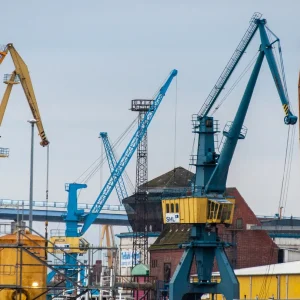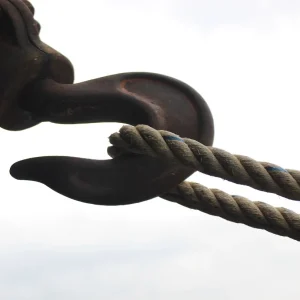
In an era dominated by rapid technological advancements, the crane builders, hoist, and industrial lifting equipment industry in North America is not immune to the transformative power of digitalisation. While these advancements bring significant improvements in efficiency, safety, and operational capabilities, they also expose the industry to a growing and ever-evolving threat: cyber insecurity. This article delves into the multifaceted impact of cyber insecurity on this critical sector, examining the vulnerabilities, potential consequences, and measures being taken to mitigate risks.
The Digital Transformation of the Industrial Lifting Equipment Industry
Embracing Technology
The integration of advanced technologies such as the Internet of Things (IoT), Artificial Intelligence (AI), and automation has revolutionised the industrial lifting equipment industry. Modern cranes and hoists are now equipped with sophisticated sensors, real-time data analytics, and remote monitoring capabilities, enabling operators to optimise performance, predict maintenance needs, and enhance overall safety.
Benefits of Digitalisation
Increased Efficiency: Automation and real-time data analytics allow for more precise and efficient operations, reducing downtime and operational costs.
Predictive Maintenance: IoT sensors and AI algorithms can predict equipment failures before they occur, minimising unexpected breakdowns and costly repairs.
Enhanced Safety: Advanced monitoring systems improve safety by providing real-time insights into equipment conditions and operational parameters, reducing the risk of accidents.
The Growing Threat of Cyber Insecurity
Understanding Cyber Insecurity
Cyber insecurity refers to the vulnerabilities and threats posed by cyberattacks on digital systems. These attacks can come in various forms, including malware, ransomware, phishing, and denial-of-service attacks. As the industrial lifting equipment industry becomes increasingly reliant on digital technologies, it becomes a more attractive target for cybercriminals.
Vulnerabilities in the Industrial Lifting Equipment Sector
- Legacy Systems: Many companies in the industry still operate with legacy systems that lack modern security features, making them easy targets for cyberattacks.
- Connected Devices: The proliferation of IoT devices, while beneficial, also introduces numerous entry points for cyber threats. Each connected device can potentially be exploited to gain access to the entire network.
- Supply Chain Risks: The interconnected nature of the supply chain means that a cyberattack on one supplier can have a cascading effect, compromising the security of the entire network.
- Human Factors: Employees’ lack of awareness and training in cybersecurity best practices can lead to inadvertent breaches, such as falling for phishing scams or using weak passwords.
Impact of Cyber Insecurity on Crane Builders and Hoist Manufacturers
Operational Disruptions
Cyberattacks can cause significant disruptions to operations. For example, a ransomware attack could encrypt critical data, rendering systems inoperable until a ransom is paid. This downtime can lead to production delays, financial losses, and damage to a company’s reputation.
Safety Risks
The integration of digital technologies in cranes and hoists is primarily aimed at enhancing safety. However, a cyberattack that compromises these systems can have the opposite effect. Malicious actors could potentially manipulate operational parameters, leading to unsafe conditions and increasing the risk of accidents.
Financial Implications
The financial impact of a cyberattack can be substantial. Companies may face direct costs such as ransom payments, system restoration expenses, and legal fees. Indirect costs, including lost business opportunities, reputational damage, and increased insurance premiums, can also add up.
Regulatory and Compliance Challenges
As cyber threats grow, so do regulatory requirements. Companies in the industrial lifting equipment industry must navigate an increasingly complex landscape of cybersecurity regulations and standards. Failure to comply can result in hefty fines and legal consequences.
Case Studies: Cyberattacks in the Industrial Sector
Notable Incidents
The Norsk Hydro Attack (2019): Norsk Hydro, a leading aluminium producer, fell victim to a ransomware attack that disrupted its operations across 40 countries. The company had to switch to manual operations, incurring significant financial losses.
The Colonial Pipeline Attack (2021): Although not directly related to the lifting equipment industry, the Colonial Pipeline attack highlighted the vulnerabilities in industrial control systems. The ransomware attack led to widespread fuel shortages and underscored the critical need for robust cybersecurity measures.
Lessons Learned
These incidents underscore the importance of proactive cybersecurity measures. Companies must prioritise securing their digital infrastructure, investing in advanced threat detection and response capabilities, and fostering a culture of cybersecurity awareness among employees.
Mitigating Cyber Risks in the Industrial Lifting Equipment Industry
Implementing Robust Security Measures
- Network Segmentation: Dividing the network into segments can help contain the spread of cyberattacks and limit their impact.
- Regular Security Audits: Conducting regular security audits and vulnerability assessments can identify and address potential weaknesses in the system.
- Advanced Threat Detection: Employing advanced threat detection and response solutions can help identify and mitigate cyber threats in real-time.
Employee Training and Awareness
Human error remains a significant factor in cybersecurity breaches. Companies should invest in comprehensive training programmes to educate employees about the latest cyber threats and best practices for safeguarding digital assets.
Collaboration and Information Sharing
Collaboration among industry stakeholders is crucial in combating cyber threats. Companies should participate in information-sharing initiatives and cybersecurity forums to stay updated on the latest threats and best practices.
Cybersecurity Insurance
Cybersecurity insurance can provide a financial safety net in the event of a cyberattack. While it does not prevent attacks, it can help mitigate the financial impact and support recovery efforts.
The Role of Government and Industry Associations
Government Initiatives
Governments in North America are increasingly recognising the importance of cybersecurity in the industrial sector. Initiatives such as the Cybersecurity and Infrastructure Security Agency (CISA) in the United States provide valuable resources and support for companies to enhance their cybersecurity posture.
Industry Associations
Industry associations, such as the Crane Manufacturers Association of America (CMAA) and the Hoist Manufacturers Institute (HMI), play a vital role in promoting cybersecurity best practices. These organisations can facilitate information sharing, provide guidelines, and advocate for stronger cybersecurity regulations.
Future Outlook: Navigating the Cybersecurity Landscape
Emerging Technologies
As technology continues to evolve, new tools and solutions are emerging to enhance cybersecurity in the industrial lifting equipment industry. Innovations such as blockchain for secure data transactions, AI-driven threat detection, and quantum encryption hold promise for creating more resilient digital infrastructures.
The Importance of Proactive Measures
The dynamic nature of cyber threats necessitates a proactive approach to cybersecurity. Companies must continually assess and update their security measures, stay informed about emerging threats, and foster a culture of cybersecurity vigilance.
Building Resilience
Resilience is key to withstanding cyberattacks. This involves not only preventing attacks but also ensuring rapid recovery and continuity of operations in the event of a breach. Companies should develop and regularly test incident response plans, ensuring they can quickly and effectively respond to cyber incidents.
Conclusion
The crane builders, hoist, and industrial lifting equipment industry in North America is at a critical juncture. While digitalisation offers numerous benefits, it also exposes the sector to significant cyber risks. By understanding the vulnerabilities, implementing robust security measures, and fostering a culture of cybersecurity awareness, companies can navigate the complex cybersecurity landscape and safeguard their operations against emerging threats. As technology continues to advance, a proactive and resilient approach to cybersecurity will be essential for ensuring the continued growth and success of the industry.






